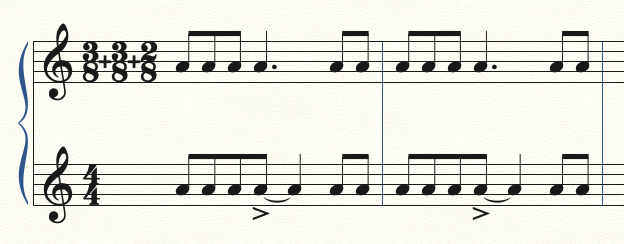Announcing two new Canons, #81 “Selenite” and #82 “Kyanite.”
These pieces were written as an exploration of the rhythmic pattern of 8 pulses divided as 3+3+2.
One place where I had encountered this pattern before is the bluegrass guitar crosspicking pattern: down-down-up, down-down-up, down-up. Another place it appears is in the final piece of Bartók’s Mikrokosmos which uses the mixed time signature 3/8+3/8+2/8 – and that’s the choice I made here.
As these pieces came together, I noticed I could feel the pulse in two different ways. It’s possible to count in eight notes “ONE-two-three ONE-two-three ONE-two” which matches where the accents actually fall in the music. But since we have a total of eight eighth notes, everything fits into a 4/4 measure. In fact, it’s possible interpret the pieces as being in 4/4 and count quarter notes “ONE-two-three-four”, in which case you’ll perceive a syncopation where the accented third beat of each 4/4 measure comes early. Here’s the rhythmic figure that occurs at the beginning of both pieces, written two ways:

Selenite and Kyanite are related by more than their rhythmic pattern: they emerged from different versions of the same outline. Selenite is a canon at the second above; Kyanite is a canon at the seventh below. Both pieces have a two-measure delay and are 21 measures long. They are dissonant canons that emphasize minor sevenths, major seconds, and perfect fourths. Instead of aiming for uniform dissonance, however, both pieces have consonances interwoven among the dissonances, aiming for some sense of tension and resolution. In these pieces I was guided by my ear and a certain sound I wanted to achieve, as opposed to any systematic policy for making contrapuntal choices; still, the question of whether something was “admissible” mostly seemed clear to me and I did not feel much uncertainty in deciding whether a particular idea fit into the sound-world I was trying to create. The one point that did cause me some questioning was the treatment of parallel fifths and octaves. Selenite took shape as one of my canons where the sound of parallel fifths is embraced; I assumed Kyanite would be the same but later I found myself editing out the many of the parallels that I had included there. Why did the parallels seem to belong in one piece but not the other that’s so similar? I have no idea.
When I finished writing Selenite I tried to swap the top and bottom lines but the result was not convincing. This surprised me because I had earlier tried inverting the skeleton (the initial outline that I used for the piece) and I liked how it sounded. Sometimes, but not always, when the skeleton for a piece responds well to inversion, the finished piece does too; in this case, it didn’t. I looked for ways to edit the inverted piece to make it work, but didn’t get very far. I felt there was still some material worth exploring, so I decided to write a new piece from the inverted skeleton. I wondered if the new piece might pair well enough with the first piece that they could live together as sections of a larger piece. But the new material turned out to be different enough that I gave it its own name, Kyanite.
I think of these as modal pieces. In Selenite, the leader starts in C Dorian, makes an excursion to C Ionian (with a glimpse of C Lydian) and returns to C Dorian. In Kyanite the leader starts in Bb Dorian, makes an excursion to Bb Lydian to Bb Ionian, and then ends in Bb Mixolydian. In both pieces, the follower uses a different mode that has the same note set as the leader. So in Selenite, for example, while the leader is in C Dorian the follower is in D Phyrgian. ■